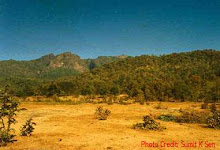Kipling Country Geography - Central Indian Highlands
Although Kipling's Jungle Book revolves around Seoni Hills, the turbulent tiger landscape was a part of the Central Indian Highlands a contiguous forest patch encompassing more than 10000 sq. km. The Sal, Teak, and mixed forests are home to incredible biodiversity in the State of Madhya Pradesh. Incidentally, Seoni Hills now encompass Pench Tiger Reserve where BBC filmed the famous documentary "The Spy in The Jungle".
The Central Indian Highlands were much accounted for by Captain James Forsyth a British explorer in the 18th Century in his book the "Highlands of Central India". The primary focus of the narrative was the terrain, wildlife, and humans of Satpura Range which meets Vindhya Range at Maikal Hills in Amarkantak.
 |
| Tiger |
In the context of habitat continuity and matching terrain, it is difficult to limit Kipling Country to any particular region in Central India that formally straddled the Vidharbha region as well. The region comprises similar habitats with a little variance except for the niche ecosystems at places due to the impact of local geography and floral content.
Maps portraying the geographical boundaries of present-day India differed from antecedents during British Rule. While it is meaningless to broach this topic, the author wishes to redefine Kipling's Country from a true geographical perspective and allay the conflict regarding the placement of Kipling Country. The geographical composition that Kipling pens in all the chapters of "Jungle Book" is prevalent from the origin of the Satpura to the whole of Vindhya an interconnected region now irrevocably fragmented.
“If history were taught in the form of stories, it would never be forgotten.”
― Rudyard Kipling, The Collected Works
Kipling's Personification of Wild Animals
Sher Khan the antihero is a legendary tertiary carnivore ironically crowned King of the jungle by man and is now critically endangered. The antihero fits well in the epic in the human context since Kipling skillfully brought forth the denizens of the jungle into life with their portrayal based as humans. Anyway, a story does well with a well-defined hero as the central character and an adversary hell-bent on destroying the hero and usurping all the goodies that come along with a win.
The personification of wild animals though a brilliant piece of work is nothing new, and in time immemorial the personification is apparent in the Holy Ramayana a factual narrative. While the phenomenon is attributed to the Supreme in the latter, Kipling's portrayal is a masterstroke of esoteric fiction. No wonder the Nobel Laurette was a genius of his times. It is difficult for a human to transfer our behavioral characteristics to beings incapable of emotions related to premeditated responses like vengeance, lust, fear, happiness, sadness, and empathy.
“Words are, of course, the most powerful drug used by mankind.”
― Rudyard Kipling
Kipling successfully endowed these behavioral characteristics to wild animals in his epic novel. No wonder the write-up was a legendary success despite being based in a dark time of extreme poverty and foreign subjugation. The human portrayal does not reflect the times since the very concept of the book dwells in the esoteric. Kiping was a white supremacist as I read in some articles, nevertheless, Indians have built a museum in his honor. Even after 75 years of independence, we are not able to shrug off the traits that define slave mentality, and for many, the white man stays superior. Indians are susceptible to non-native esoteric ideologies that flout native concepts. (All the creation and infrastructure during the Raj has come at a cost and the natives paid a heavy price for that to the erstwhile masters.) (And we still goad over the gifts).
The Jungle Book narrative is excellent for imaginary recreational pursuit but it does carry a wrong message.
Victimizing the Tiger & Impact of Literature
The tiger is, by all means, an animal considered at the top of the food pyramid, and labeled as King of the jungle. Nonetheless, he is portrayed as an antihero thirsting for the manchild's blood. The portrayal in several folklores including modern portrayals like in the Jungle Book has victimized the animal no end. This characterization of the big cat stems from the age-old threat perception of predators during those times in many parts of the World. The tiger in India was relentlessly slaughtered in the guise of human safety, its habitat destroyed as an agrarian necessity, and hunted down to prove killer instinct and masculinity in young officers during the Raj.
I read a book by an Indian author stating that in a period of ten years around 25 thousand tigers were butchered for a small price paid to the hungry vermin killers. It is not only the economic price we have paid for slavery at hands of the Mughals and the British, the cultural and demographic sacrifices, and the human toll has exceeded the limits set by genocide in the present context.
 |
| Pachmarhi |
Despite the absence of anti tiger narrative in the Hindu Pantheon, the Maharajahs and Indian elites were as much responsible for the pathetic status of the tiger in Pre and Post Independent India. It was pure recreation justified by the unchallenged power of the throne, bestowed masculine perceptions and the religious sanctities accorded by the priests. The Satraps left no stones unturned to please their masters during and even after the Raj. In post-independent India, substantial revenue was generated from tiger shoots besides the ongoing slaughter. It was the WPA 1972 that stemmed the rot. More than 3000 tigers survive today thanks to intense tiger conservation.
Akela The Wolf & Other Predators
Akela's paternal endearment towards Mowgli, acceptance as a pack member, and Baloo and Bagheera's emotional attachment to the naked child are the personification of the human form. But ironically, the depiction clearly points toward the superiority of humans over lesser beings. We have yet to acknowledge that Earth belongs to all life forms. Baloo the bear, and Baghira are badly treated in human confines and the latter is on verge of extinction in India.
The story portrays Kaa the python, Tabaqui (Jackal), and other birds and animals as ugly and evil and this does not help in changing human perceptions about these beautiful creatures. Though there was no malicious intent as far as the book is concerned the characterization does no good. The predators are now on the list of critically endangered animals.
Highlands of Central India
This amazing landscape described above encompasses many tiger reserves and hill resorts. The reserves are home to the tiger and many species of mammals, insects, reptiles, and birds.
The reserves are wild holiday hotspots where tiger safari and birding trips are organized. All the holiday destinations are picturesque, and home to some spectacular panoramic spectacles. Tourism is well organized in these remote destinations, and there is a rush during the holidays and in the winter season. Unlike overcrowded hill resorts, tiger reserves are protected by limiting human entry and the safari is an experience in isolation since the jeeps rarely club together. Sooner or later the authorities will have to curb movement in the hill resorts as well.
Places of Interest
- Nauradehi Wildlife Sanctuary
- Panna Tiger Reserve
- Bandhavgarh National Park
- Pench National Park
- Kanha Tiger Reserve
- Satpura Tiger Reserve
- Pachmarhi Hill Resort
- Amarkantak Hill Resort
- Sanjay Dubri National Park
Prior booking is advised for holiday making in these destinations. Tiger safari is organized only for permit holders. Permits are issued by MP State Government on MPOnline Portal. One must visit the hill resorts in summers but never during the holiday period, and thus, prevent stress on the infrastructure and the environment as well. Unfortunately, the hill resorts in Madhya Pradesh experience a greater rush during the weekends and the winter holidays.
Some family safe properties are :
- Jabalpur/Nauradehi - Krisha Hotel & Culchuri (MPTDC) Jabalpur
- Pachmarhi - (MPTDC Hotels)
- Pench -Mowgli's Den, Jungle Home Pench & Tathastu Resort
- Satpura - Forsyth's Lodge & Denwa Backwater Resort
- Bandhavgarh - Tigers Den
- Kanha - Courtyard House
- Sanjay Dubri - Sandbeach Resort & MPTDC
The destinations are approachable from Jabalpur Airport in Madhya Pradesh. Pench National Park is closest to Nagpur Aiport in Maharashtra.





























